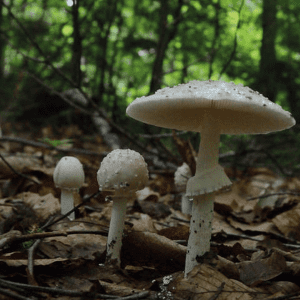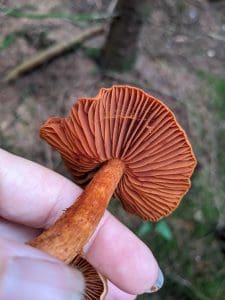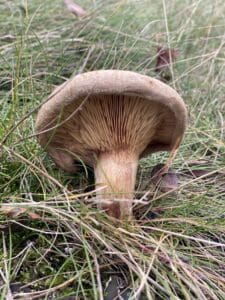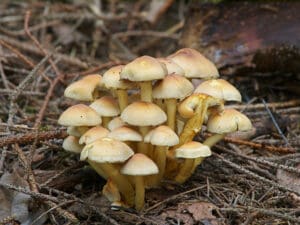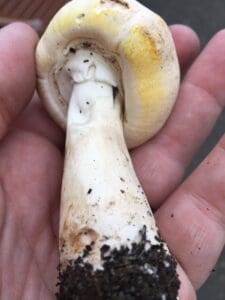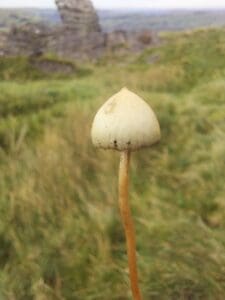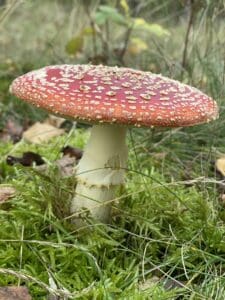As an avid forager and mushroom enthusiast, I used to be really worried about poisonous mushrooms in the UK, I’ve always been fascinated by the diverse world of fungi in the UK. But let me tell you, not all mushrooms are created equal! Some can be downright dangerous, and that’s why I’m here to share my knowledge about poisonous mushrooms in the UK. From the infamous death cap to the deceptively pretty Fly Agaric, our woodlands and fields are home to some seriously toxic fungi that we need to watch out for.
In this guide, we’ll explore the top 20 poisonous mushrooms you might come across in the UK. I’ll walk you through their scientific names, appearance, and the nasty effects they can have on your body if ingested. We’ll also dive into some fascinating historical titbits about these fungi, including some rather grim tales of poisonings from the past. So, whether you’re a curious nature lover or a budding mycologist, stick with me as we embark on this eye-opening journey through the world of dangerous mushrooms in the UK!
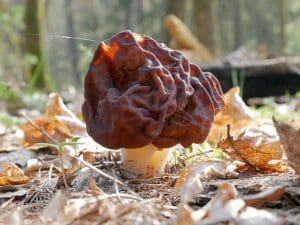
Listen to the Podcast on Deadly Mushrooms here..
This is an ai generated podcast that we’re sharing because our team genuinely have found it useful.
Death Cap (Amanita phalloides)
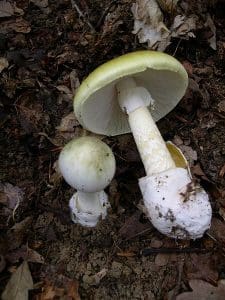
Identification
The death cap, scientifically known as Amanita phalloides, is one of the most dangerous poisonous mushrooms in the world. Its cap ranges from 4 to 16 cm in diameter, with colours varying from greenish-yellow to brown or tan. The flesh inside is white and doesn’t change colour when sliced. Young mushrooms are covered by a universal veil that becomes a bulbous base as they mature. A distinctive feature is the ring, or annulus, on the stipe, which is white or yellowish and 4 to 18 cm long.
Habitat
Death caps are mycorrhizal fungi, forming symbiotic relationships with tree roots. They’re typically found near broad-leaved trees like oaks, birches, and elms. In some areas, they’ve been associated with pine trees, possibly due to a different strain or competition with other Amanita species.
Toxicity
The death cap contains three main types of mycotoxins: amatoxins, phallotoxins, and virotoxins. Amatoxins are the most dangerous, preventing DNA production and leading to liver and kidney failure. Shockingly, a single mushroom can contain many times the fatal dose. Even half a cap, about 30 grams, is enough to kill an adult human.
Several historical figures are believed to have fallen victim to death cap poisoning. These include Roman Emperor Claudius and Holy Roman Emperor Charles VI. Charles VI’s death, allegedly caused by a dish of sautéed mushrooms, led to the War of Austrian Succession. As Voltaire noted, “This mushroom dish has changed the destiny of Europe”.
Death Cap (Amanita phalloides) Identification
Destroying Angel (Amanita virosa)
Identification
The destroying angel, a deadly poisonous mushroom found in the UK, is a sight to behold. Like all Amanita’s they begin life as a volva or egg sac, this breaks and the main fruiting body emerges. Its cap, ranging from 3 to 10 cm in diameter, is pure white and smooth, sometimes with a pale tan or cream-coloured tint in the centre. The shape can vary from convex when young to flat or slighty funnel shaped when mature. The gills are white, crowded, and free from the stipe. The stem, 9 to 15 cm tall and 0.6 to 2 cm in diameter, is white and fibrous with a fragile ring near the top. A distinctive feature is the large, sack-like volva at the base, often buried in the soil.
Habitat
This dangerous mushroom prefers deciduous or mixed woodlands, often found at the edges. It’s more common at higher altitudes in Britain and Ireland but can be spotted in lower areas, especially in Scotland. The destroying angel is also prevalent in European coniferous forests, particularly in Scandinavia. It typically appears from August to November in Britain.
Toxicity
The destroying angel contains amatoxins, which are incredibly potent and deadly. Symptoms of poisoning begin 6 to 24 hours after consumption, including severe abdominal pain, vomiting, and diarrhoea. Deceptively, these symptoms may subside, leading to a false sense of recovery. However, liver and kidney damage continues, potentially resulting in coma and death within 4 to 7 days if left untreated.
Destroying Angel (Amanita virosa) Identification
Funeral Bell (Galerina marginata)
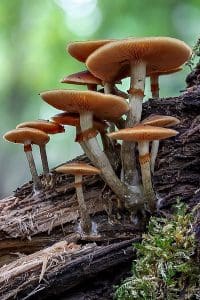
Identification
The funeral bell, also known as the deadly skullcap or autumn skullcap, is a deceptively small but extremely poisonous mushroom. Its cap ranges from 1 to 4 cm in diameter, starting convex and flattening with age. The colour varies from rust to apricot, fading when dry. The gills are narrow, crowded, and brownish, turning rusty as they mature. The stem, 2 to 8 cm long, has a membranous ring that may disappear in older specimens.
Habitat
We often find this dangerous mushroom growing on stumps, dead trunks, and fallen branches of conifers. It’s also occasionally spotted on broad-leaved trees. While not particularly common, it’s widespread across Britain, typically appearing in late summer and autumn.
Toxicity
The funeral bell contains deadly amatoxins, the same toxins found in the death cap mushroom. These compounds inhibit RNA polymerase II, disrupting liver cell metabolism. Ingestion causes severe abdominal pain, vomiting, and diarrhoea within hours. Without prompt treatment, it can lead to liver failure, coma, and death within a week. The lethal dose is alarmingly low, estimated at about 0.1 mg/kg of body weight or even less.
Funeral bell Mushroom (Galerina Marginata) Identification
Deadly Webcap (Cortinarius rubellus)
Identification
The deadly webcap is a deceptively ordinary-looking poisonous mushroom found in the UK. Its cap ranges from 2.5 to 8 cm in diameter, with a conical to convex shape that flattens with age. The colour is tawny to date brown, with paler margins and fine, fibrous scales. The gills are ochre or caramel-coloured, darkening to brown as spores mature. The stipe, 5.5 to 11 cm tall, has a bulbous base and may have yellow veil fragments on its lower half. A key identifier is the cortina, web-like fibres covering young gills. The flesh is cream or pale yellow, with a slight radish smell.
Habitat
This dangerous mushroom prefers wet areas in conifer or mixed woodlands, particularly those with acidic soil. It’s mycorrhizal with conifers, especially pine and spruce. While rare in southern UK, it’s more common in Scotland and northern Europe. The deadly webcap typically appears from late summer to early winter, often growing in groups.
Toxicity
The deadly webcap contains orellanine, a powerful mycotoxin causing severe kidney damage. Symptoms can be delayed by up to two days, starting with flu-like signs, vomiting, and abdominal pain. Without prompt treatment, it can lead to total renal failure. In 1979, three people in Scotland were poisoned after mistaking it for chanterelles, with two requiring kidney transplants.
Deadly Webcap Mushroom (Cortinarius rubellus) – Deadly Toxic
Panther Cap (Amanita pantherina)
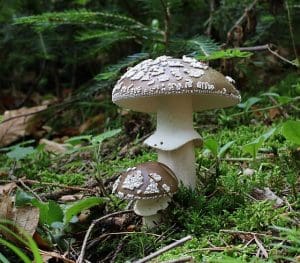
Identification
The panther cap is a visually striking poisonous mushroom found in the UK. Its cap, ranging from 5 to 12 cm in diameter, is deep brown to slightly reddish-brown, covered with thick white spots resembling a panther’s coat. Initially domed, the cap flattens as it matures. The gills and flesh are white, and the stem has a hanging ring that becomes thin and floppy in older specimens. The base is slightly swollen with white volva remains.
Habitat
This uncommon mushroom prefers deciduous woodlands, especially beech forests, and is occasionally found in coniferous areas. It’s an ectomycorrhizal fungus, forming a symbiotic relationship with tree roots. While native to Europe and western Asia, it has been reported in South Africa, possibly due to imported trees.
Toxicity
The panther cap contains ibotenic acid and muscimol, which have psychoactive properties. These compounds can cause hallucinations, synaesthesia, and altered time perception. Effects resemble those of Ambien at high doses rather than classical psychedelics. Symptoms of poisoning include dizziness, confusion, and increased sensitivity to visual and auditory stimuli. In severe cases, it can lead to seizures, coma, and persistent headaches.
Panther Cap (Amanita Pantherina) Identification
Fool’s Funnel (Clitocybe rivulosa)
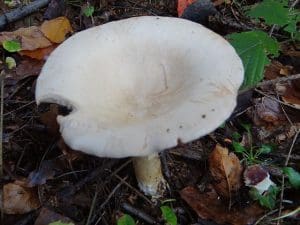
Identification
The Fool’s Funnel, a dangerous mushroom found in the UK, is a deceptive little fungus. Its cap, ranging from 3 to 6 cm wide, starts convex but flattens with age, often developing a wavy margin. The cap is smooth and floury when dry, appearing white with a slight buffish tinge as it matures. The gills are crowded and white, sometimes developing a greyish-pink hue. The stem, 3 to 4 cm long, is smooth and white with a downy base. This poisonous mushroom often grows in fairy rings, making it easily confused with edible species.
Habitat
These mushrooms are fairly common in unimproved grasslands, particularly in parks, gardens and on roadside verges. But they can also appear in coastal sand dune systems. Because they grow in places people expect to find edible fungi they are a serious risks to the inexperienced forager. This poisonous mushroom often grows in fairy rings, making it easily confused with edible species such as the St. Georges mushroom (Calocybe gambosa) and Fairy Ring Champignons (Marasmius oreades).
Toxicity
The Fool’s Funnel contains muscarine, a potent toxin that makes it one of the most dangerous poisonous mushrooms in the UK. This compound is responsible for its severe toxic effects, making it a serious threat to foragers and mushroom enthusiasts.
Ingesting the Fool’s Funnel can lead to muscarine poisoning, with symptoms appearing within 30 minutes. These include excessive salivation, sweating, and tearing. In severe cases, victims may experience abdominal pain, nausea, blurred vision, and laboured breathing. While deaths are rare in healthy adults, those with heart or respiratory conditions are at higher risk. Prompt medical attention is crucial if poisoning is suspected.
Fools Funnel (Clitocybe Rivulosa) Identification
Ivory Funnel (Clitocybe dealbata)
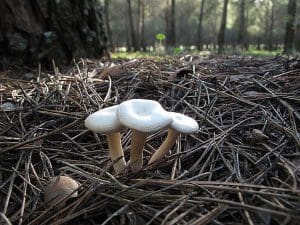
Identification
There is some controversy as to whether Clitocybe rivulosa and Clitocybe dealbata are close variants of the same species or separate species, with C. dealbata growing inland and C. rivulosa growing nearer the coast.
The ivory funnel is a small but dangerous mushroom found in the UK. Its cap, 2-4 cm wide, starts convex but flattens with age, often developing a central depression. The colour is almost pure white when young, becoming greyer as it matures. The gills are white initially, turning grey with a pinkish tinge over time. The stem, 2-4 cm tall, matches the cap’s colour and has a slightly downy base.
Habitat
These mushrooms are fairly common in unimproved grasslands, particularly in parks, gardens and on roadside verges. But they can also appear in coastal sand dune systems. Because they grow in places people expect to find edible fungi they are a serious risks to the inexperienced forager. This poisonous mushroom often grows in fairy rings, making it easily confused with edible species such as the St. Georges mushroom (Calocybe gambosa) and Fairy Ring Champignons (Marasmius oreades).
The ivory funnel contains muscarine, a potent toxin that makes it one of the most dangerous poisonous mushrooms in the UK. This compound is responsible for its severe toxic effects, posing a serious threat to foragers and mushroom enthusiasts.
Toxicity
Ingesting the ivory funnel can lead to muscarine poisoning, with symptoms appearing within 15-30 minutes. These include excessive salivation, sweating, and tearing. In severe cases, victims may experience abdominal pain, nausea, blurred vision, and laboured breathing. While deaths are rare in healthy adults, those with heart or respiratory conditions are at higher risk. Prompt medical attention is crucial if poisoning is suspected.
Ivory Funnel (Clitocybe Dealbata) Identification
Fool’s Webcap (Cortinarius orellanus)
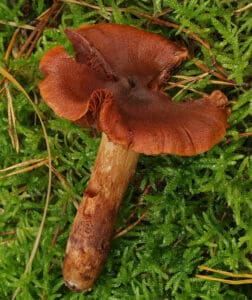
Identification
The Fool’s Webcap is a medium-sized mushroom with a distinctive appearance. Its cap, ranging from 3 to 7 cm in diameter, starts convex but flattens with age, often retaining a slight umbo. The cap colour is tawny-brown to reddish-orange, with a dry, slightly scaly surface, especially in the centre. The gills are widely spaced and pale yellowish initially, turning red as spores mature. The stem, 5 to 10 cm tall and 7 to 15 mm in diameter, is often slightly bowed and paler than the cap. Unlike its deadly cousin, the Deadly Webcap, the Fool’s Webcap lacks a pronounced yellowish snakeskin-like pattern on its stem.
Habitat
They form ectomycorrhizal relationships with tress, mostly with hardwood trees (especially oak) but sometimes also with conifers, on both alkaline and acidic soils. Luckily they are quite rare in the UK but are more common in others parts of Europe.
Toxicity
The Fool’s Webcap contains orellanine, a highly nephrotoxic bipyridine N-dioxide. This potent toxin rapidly concentrates in the kidneys, causing severe damage. Orellanine content in dried fungus can vary greatly, with C. orellanus containing about 14,000 mg/kg. This dangerous mushroom is responsible for several poisoning cases in Europe and North America, often mistaken for edible species like chanterelles.
The nephrotoxicity of C. orellanus was first recognised in the 1950s after a mass poisoning in Poland. Another case from 1997 involved an Austrian woman and her daughter, who while holidaying in Ireland, picked mushrooms later identified as Fool’s Webcaps, and ate them in a soup. Two weeks later, after suffering abdominal pains, vomiting and diarrhoea, they were hospitalised and the mother was found to have acute renal failure. The daughter, who had eaten a smaller amount of the soup, had less severe kidney damage. With dialysis and other medication over many weeks, their lives were thankfully saved.
Brown Roll-rim (Paxillus involutus)
Identification
The brown roll-rim is a medium-sized poisonous mushroom found in the UK. Its cap, 6-20 cm wide, starts convex but flattens with age, developing a central depression. The colour is rusty brown, with a slimy surface when wet. A distinctive feature is the inrolled cap margin, giving it its common name. The gills are pale yellow-brown, crowded, and bruise darker when damaged. The stem, 6-12 cm tall, is light ochre, becoming chestnut brown with age or if bruised.
Habitat
A common mushroom of deciduous and coniferous woods in late summer and autumn, Paxillus involutus forms ectomycorrhizal relationships with a broad range of tree species. They have also been known to appear in heaths, lawns and old meadows.
Toxicity
The brown roll-rim contains unknown toxins that can cause severe autoimmune reactions. These compounds trigger the immune system to attack red blood cells, leading to haemolytic anaemia. This can result in acute kidney injury, shock, and respiratory failure.
In 1944, German mycologist Julius Schäffer died after eating brown roll-rims. Within an hour of consumption, he developed vomiting, diarrhoea, and fever. His condition worsened, leading to kidney failure and death after 17 days.
Despite its toxicity, the brown roll-rim was previously considered edible and widely consumed in Eastern and Central Europe. In Poland, it was often eaten after pickling or salting. It wasn’t until 1990 that guidebooks firmly warned against its consumption.
Brown Roll-rim (Paxillus involutus) identification
Livid Pinkgill (Entoloma sinuatum)
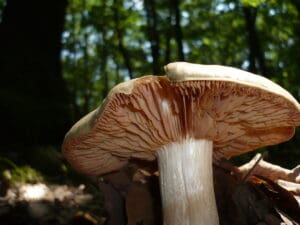
Identification
The livid Pinkgill, also known as the lead poisoner, is a striking poisonous mushroom found in the UK. Its cap, ranging from 6 to 20 cm in diameter, starts convex but flattens with age, often developing a blunt umbo. The colour is ivory white to light grey-brown, darkening over time. A distinctive feature is its wavy margins and rolled inward edge. The gills are initially pale yellowish, turning pink and then red as spores mature. The thick whitish stem, 4 to 20 cm tall, lacks a ring. This imposing fungus often grows in deciduous woodlands, sometimes forming fairy rings.
Habitat
This imposing fungus often grows in deciduous woodlands, sometimes forming fairy rings, but they may spread to in parks, fields and grassy areas nearby. Most members of the genus are saprotrophic, although this species has been recorded as forming an ectomycorrhizal relationship with willow.
Toxicity
While the exact toxins in the Livid Pinkgill remain unidentified, chemical analysis has revealed the presence of alkaloids. These compounds cause severe gastrointestinal distress, with symptoms appearing 30 minutes to 2 hours after consumption. Effects can include diarrhoea, vomiting, and headaches, lasting up to 48 hours. In rare cases, acute liver toxicity and psychiatric symptoms like mood disturbances or delirium may occur. This dangerous mushroom is responsible for about 10% of all mushroom poisonings in Europe.
Sickener (Russula emetica)
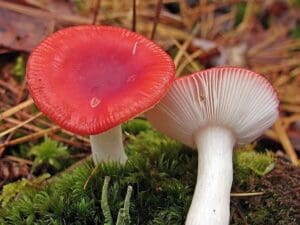
Identification
The Sickener, a poisonous mushroom found in the UK, has a striking appearance. Its cap, 2.5-8.5 cm wide, is bright scarlet or cherry red, starting convex and flattening with age. The cap’s cuticle can be peeled almost to the centre, revealing white or pinkish flesh beneath. The gills are white to pale cream, closely spaced, and either free or attached to the stem. The smooth white stem can reach 10.5 cm in length and 2.4 cm in thickness.
Habitat
Like all species of Russula, The Sickener is mycorrhizal, and forms mutually beneficial partnerships with the roots of trees and plants. This brittlegill mushroom is commonly found in coniferous woodlands and occasionally on mossy heathlands from August to October.
Toxicity
While the exact toxins in the Sickener remain unidentified, they’re believed to be sesquiterpenes. These compounds have been isolated from related fungi and are thought to cause the mushroom’s toxic effects. Specific sesquiterpenoids found in R. emetica include lactarorufin A, furandiol, methoxyfuranalcohol, and a unique unnamed compound.
Ingesting the Sickener can lead to severe gastrointestinal distress. Symptoms typically appear within 30 minutes to three hours after consumption and include nausea, vomiting, diarrhoea, and abdominal cramps. While these effects usually subside on their own, they can be quite unpleasant. Despite its toxicity when raw, some Eastern European countries traditionally consumed it after parboiling and pickling, though this practise is not recommended.
Sickener (Russula emetica) identification
Sulphur Tuft (Hypholoma fasciculare)
Identification
The sulphur tuft is a striking poisonous mushroom found in UK woodlands. Its cap, 2-6 cm wide, starts convex and flattens with age, displaying a vibrant sulphur-yellow colour with an orange-brown centre. The gills are crowded and initially yellow, turning olive-green and eventually blackish as spores mature. The stem, 3-10 cm tall, matches the cap’s colour but darkens at the base. These fungi often grow in dense clusters on decaying wood, forming impressive displays from spring through autumn.
Habitat
The Sulphur Tuft is a common saprobe and grows prolifically on the dead wood of both deciduous and coniferous trees. It is more commonly found on decaying deciduous wood due to the lower lignin content of this wood and it can appear anytime from spring to autumn.
Toxicity
Sulphur tufts contain fasciculol E and F, toxic steroids that cause severe gastrointestinal distress. These compounds have been shown to be calmodulin inhibitors, affecting cellular processes.
Ingesting sulphur tufts can lead to severe poisoning. Symptoms typically appear 5-10 hours after consumption and include nausea, vomiting, explosive diarrhoea, and in some cases, temporary paralysis and distorted vision. While rarely fatal, at least one death has been reported, with autopsy revealing fulminant hepatitis reminiscent of amatoxin poisoning.
Sulphur Tuft (Hypholoma fasciculare) identification
Yellow Stainer (Agaricus xanthodermus)
Identification
The Yellow Stainer is a poisonous mushroom found in the UK that closely resembles edible field mushrooms. Its cap, 5-14 cm wide, starts rounded with a slightly cubed shape, flattening to a shallow convex. Initially white, it can turn brown or greyish-brown with age. The gills are crowded and free, starting white, then turning pink and finally dark purplish-brown. The stem, 5-13 cm long, has a bulbous base and a large, floppy ring. A distinctive feature is its bright yellow staining when bruised or cut, particularly noticeable at the stem base.
Habitat
This mushroom is very common and widely distributed across Europe. It’s a saprobic species that occurs in woods, lawns, gardens and hedgerows in autumn, often in small groups but occasionally singly.
Toxicity
While the exact toxins remain unidentified, the Yellow Stainer contains phenol, which causes gastrointestinal distress. The severity of symptoms varies depending on the amount consumed and individual sensitivity.
The yellow stainer is responsible for the most cases of mushroom poisoning in the UK. While exact figures for the UK are unavailable, it’s estimated that around a thousand people are poisoned annually due to consuming wild mushrooms, including Yellow Stainers.
In 2022, over 600 cases of mushroom poisoning were reported to French poison control centres, with a peak in October.
Yellow Stainer (Agaricus xanthodermus) identification
Poisonpie (Hebeloma crustuliniforme)
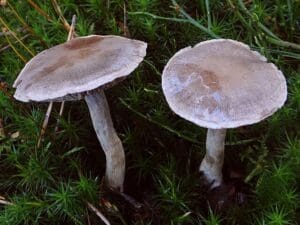
Identification
The Poisonpie, a toxic mushroom found in UK woodlands, has a distinctive appearance. Its cap, 3-10 cm wide, starts convex with an inrolled margin, developing a wide umbo as it matures. The colour ranges from off-white to pale tan, often darker in the centre. The cap feels sticky or greasy, especially in damp conditions. The gills are initially white, turning pale grey-brown with age, and can form dark droplets in moist environments. The stem, 4-9 cm tall, has a wider base and lacks a ring. A key identifier is its strong radish-like smell.
Habitat
They are a mycorrhizal species and can be found under broad-leaved and coniferous trees; sometimes singly but more often in scattered tufted groups of typically 2 to 5 fruitbodies.
Toxicity
While the exact toxins in the Poisonpie aren’t fully identified, it contains muscarine, a neurotoxin, and other gastrointestinal irritants. These compounds contribute to its poisonous nature and can cause severe reactions when ingested.
Consuming the Poisonpie can lead to severe gastrointestinal distress. Symptoms typically appear within 30 minutes of ingestion and include nausea, vomiting, diarrhoea, and abdominal pain. In some cases, it may cause more severe reactions. Despite its name, this mushroom is definitely not for eating and should be avoided by foragers.
Magic Mushrooms (Psilocybe semilanceata) – illegal and hallucinogenic
Identification
Liberty caps, scientifically known as Psilocybe semilanceata, are small mushrooms with distinctive conical to bell-shaped caps. The caps measure up to 2.5 cm in diameter and feature a small nipple-like protrusion on top. Their slender stems are usually the same colour or slightly lighter than the cap. The gills start cream-coloured but turn purple to black as spores mature. These mushrooms grow in grassland habitats, especially wetter areas.
Habitat
These mushrooms grow in grassland habitats, especially in wetter areas, they fruit singularly or in groups on rich and acidic soils, such as meadows, pastures, or lawns. It is often found in pastures that have been fertilised with sheep or cow dung, although it does not typically grow directly on the dung.
Toxicity
Liberty caps contain psilocybin, psilocin, and baeocystin. Psilocybin is converted to psilocin in the body, which is the primary psychoactive compound. On average, these mushrooms contain 1% psilocybin, ranging from 0.2% to 2.37%, making them one of the most potent species.
Ingesting liberty caps can cause visual distortions of colour, depth, and form, progressing to visual hallucinations. Effects are similar to LSD but milder. Common side effects include pupil dilation, increased heart rate, and over-responsive reflexes. The impact on mood varies depending on the individual’s personality traits.
Long Term Affects and Research Studies
While most cases of intoxication resolve without incident, severe consequences can occur with higher dosages or persistent use. Recent studies suggest psilocybin may have potential therapeutic benefits for depression and other mental health conditions. However, more research is needed to fully understand its long-term effects and safety profile.
Liberty Cap (Psilocybe semilanceata) identification
Deadly Fibrecap (Inocybe erubescens)
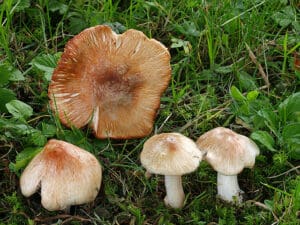
Identification
The Deadly Fibrecap, a highly poisonous mushroom in the UK, has a distinctive appearance. Its cap, 4-10 cm wide, starts conical and flattens with age, retaining a pointed umbo. The cap colour ranges from ivory white to cream, staining bright red or pinkish-orange over time. Fine fibres radiate from the centre, often splitting at the edge. The gills begin cream-coloured, turning pale cigar brown and slowly staining red when bruised. The stem, 3-10 cm long and 0.8-1.5 cm in diameter, is white and stains vivid red when touched.
Habitat
They are a mycorrhizal species, that occurs singly or in small groups beneath deciduous trees, most notably Beeches and Hornbeams nearly always on alkaline or at least neutral soil.
Toxicity
The Deadly Fibrecap contains a lethal concentration of muscarine, making it one of the most dangerous poisonous mushrooms in the UK. This toxin is responsible for its severe toxic effects, posing a serious threat to foragers and mushroom enthusiasts.
Ingesting the Deadly Fibrecap can lead to muscarine poisoning, causing gastric upsets, excessive sweating, salivation, and a slower heart rate. In severe cases, it can be fatal. The toxin acts rapidly, with symptoms appearing within a short time after consumption. Prompt medical attention is crucial if poisoning is suspected, as deaths associated with this mushroom have occurred in the UK and Continental Europe.
Deadly Fibrecap (Inocybe erubescens) identification
Fly Agaric (Amanita Muscaria)
Identification
The Fly Agaric (Amanita muscaria) is one of the most iconic mushrooms, easily recognized by its bright red cap, which is covered with white, wart-like spots. The cap is typically 8-20 cm wide, starting convex and flattening with age. The spots, remnants of a universal veil, can sometimes wash off, leaving the cap smooth. The gills are white and free from the stem, densely packed, and the spore print is white. The stem is 10-20 cm long, white, with a bulbous base and a fragile, white ring halfway up. At the base, remnants of a volva (egg-like structure) can be seen, but it’s often torn or hard to distinguish.
Habitat
Toxicity
Angel’s wings (Pleurocybella porrigens)
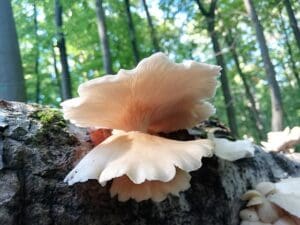
Identification
Habitat
Toxicity
While Pleurocybella porrigens was once considered edible, recent reports have linked its consumption to serious health risks, especially in individuals with compromised kidney function. In Japan, there have been several cases of fatal poisoning, with symptoms including confusion, weakness, and, in severe cases, encephalopathy (brain damage) and death.
The exact toxic compounds responsible remain unidentified, and poisoning appears to be relatively rare, but caution is advised when considering foraging this species. Due to these risks, it is now generally recommended to avoid consuming Angel’s Wings.
Angel’s wings (Pleurocybella porrigens) identification
Fatal Dapperling (Lepiota subincarnata)
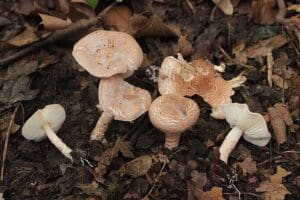
Identification
The Fatal Dapperling (Lepiota subincarnata) is a small but deadly mushroom. Its cap is typically 2-5 cm wide, starting conical and flattening as it matures, often with a slightly raised center. The cap colour ranges from pale pinkish-brown to flesh-coloured, with darker, concentric scales, especially toward the centre. The gills are free, crowded, and white, turning slightly pinkish or cream with age. The stem is slender, 3-6 cm long and 0.3-0.6 cm thick, white to pinkish, with a fragile ring that may disappear as the mushroom ages. The spore print is white.
Habitat
Lepiota subincarnata grows in nutrient-rich soil, often found in gardens, parks, grassy areas, and occasionally in woodlands. This species tends to grow in small groups or scattered individually, primarily in late summer and autumn. It is widespread across Europe and has also been reported in North America and parts of Asia. Despite its small size, it can easily be mistaken for edible mushrooms, especially by inexperienced foragers.
Toxicity
False Morel (Gyromitra esculenta)

Identification
The False Morel (Gyromitra esculenta) has a distinct, brain-like or saddle-shaped cap, typically 3-10 cm wide and 2-8 cm high. The cap colour ranges from reddish-brown to dark brown and is deeply wrinkled, with a lobed or folded appearance. Unlike true morels, the cap is not uniformly attached to the stem and is often irregularly shaped. The stem is white to pale yellow, hollow, and relatively short, usually 3-6 cm in height and 2-4 cm wide, though its size can vary depending on growing conditions. The flesh is brittle, and when cut open, the cap reveals a chambered or hollow structure inside.
Habitat
Gyromitra esculenta is found in sandy soils, especially in coniferous forests, often near pines and spruces. These mushrooms appear in early spring to early summer, commonly growing near decomposing wood, stumps, or in disturbed soil areas. They are widespread and they can sometimes be found in large quantities.
Toxicity
Conclusion
The exploration of poisonous mushrooms in the UK reveals a fascinating yet dangerous world beneath our feet. From the deadly death cap to the deceptive yellow stainer, these fungi pose significant risks to foragers and nature enthusiasts alike. The diverse array of toxins found in these mushrooms, including amatoxins, muscarine, and orellanine, has the potential to cause severe health issues ranging from gastrointestinal distress to organ failure. This underscores the importance of expert knowledge and caution when dealing with wild mushrooms.
While some of these poisonous fungi have played roles in historical events and continue to be subjects of scientific research, their primary significance lies in the need for public awareness and education. The stories of poisonings and near-misses serve as sobering reminders of nature’s power and complexity. To stay safe, it’s crucial to approach mushroom foraging with respect, knowledge, and a healthy dose of caution, always consulting experts when in doubt. The world of fungi continues to fascinate and challenge us, offering both dangers and opportunities for learning.
FAQs
What is the most lethal mushroom found in the UK?
The Death Cap (Amanita phalloides) is the most dangerous mushroom in the UK. It contains alpha-amanitin, which leads to severe liver and kidney failure and is considered the most deadly fungus globally, particularly prevalent in England.
Which mushroom is recognised as the most poisonous worldwide?
Globally, the most poisonous mushroom is the Death Cap (Amanita phalloides). Found in regions like BC, the amatoxins present in this mushroom are responsible for approximately 90% of all fatal mushroom poisoning cases worldwide.
Which mushrooms should I steer clear of?
It’s advisable to avoid several highly toxic mushrooms, including the Death Cap (Amanita phalloides), Conocybe filaris, various Webcaps (Cortinarius species), Autumn Skullcap (Galerina marginata), Destroying Angels (Amanita species), Podostroma cornu-damae, and the Deadly Dapperling (Lepiota brunneoincarnata).
What are the signs of mushroom poisoning in the UK?
Symptoms of mushroom poisoning can begin 6 to 12 hours after consumption, starting with vomiting and diarrhoea. In some cases, there’s a dangerous drop in blood sugar levels (hypoglycemia). After an initial subsidence of symptoms, severe liver and potentially kidney failure can occur, leading to jaundice (yellowing of the skin).
References
https://www.first-nature.com/fungi/amanita-virosa.php
https://plants.ces.ncsu.edu/plants/amanita-bisporigera/
https://www.naturespot.org.uk/species/funeral-bell
https://totallywilduk.co.uk/2024/08/22/deadly-webcap-mushroom/
https://www.sciencedirect.com/topics/agricultural-and-biological-sciences/amanita-pantherina
https://www.first-nature.com/fungi/cortinarius-orellanus.php
https://journals.sagepub.com/doi/full/10.1177/0960327115613845
https://www.mushroom-appreciation.com/sulphur-tuft.html
https://www.anses.fr/en/content/wild-mushroom-season
https://www.cnn.com/2022/06/11/health/psilocybin-brain-changes-life-itself-wellness-scn/index.html



